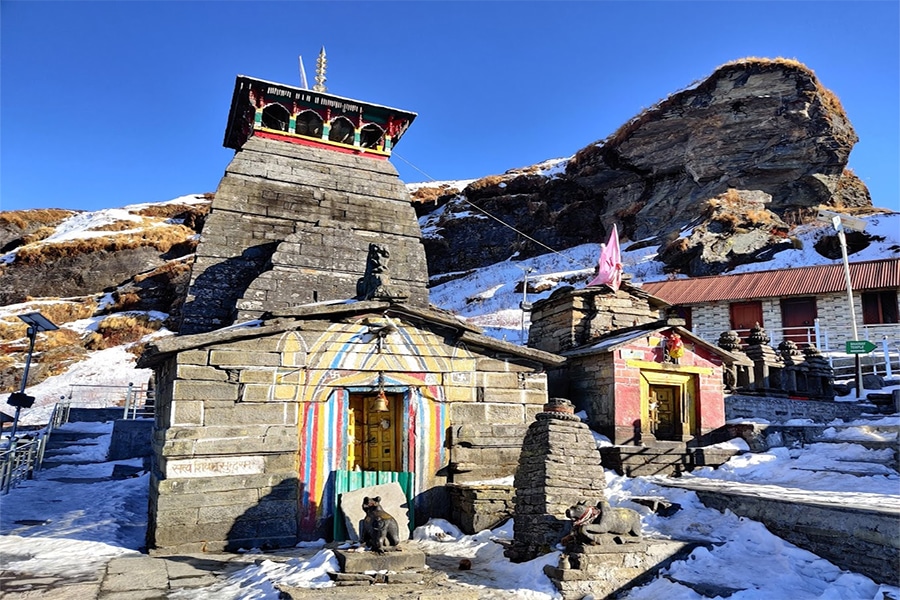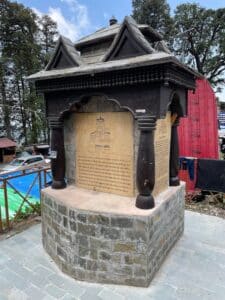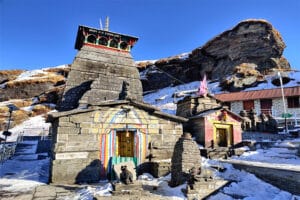Tungnath Temple – Uttarakhand:
One of the highest Shiva temples worldwide, Tungnath is the highest of the five Panch Kedar temples, situated in the Rudraprayag area of Uttarakhand, India. The Mandakini and Alaknanda river valleys are formed by the Tungnath (literally, “Lord of the peaks”) mountains. Tungnath Temple is situated immediately below Chandrashila’s peak at a height of 3,690 metres (12,106 feet). Rich legend connects it to the Pandavas, the epic heroes of Mahabharata.
Tungnath is one of the Panch Kedar, a group of five sacred temples dedicated to Lord Shiva in the Garhwal region. The word “Tungnath” itself is a combination of two Sanskrit words, “tunga” meaning high, and “nath” meaning lord. Pilgrims undertake the challenging trek to Tungnath not just for its geographical height but also for the spiritual ascent it represents. The temple holds a profound significance for devotees who seek the blessings of Lord Shiva for inner strength and liberation.
Tungnath Temple History:
Nestled amidst the breathtaking peaks of the Garhwal Himalayas in Uttarakhand, Tungnath Temple stands as a testament to the rich spiritual heritage of India.It is not only the highest Shiva temple in the world but also a revered destination for pilgrims, trekkers, and seekers of tranquillity. The history of Tungnath Temple weaves together the threads of mythology, devotion, and the natural grandeur of the Himalayan landscape.
Hindu legend states that Shiva lives atop Mount Kailash in the Himalayas, as does his consort Parvati. Another name for Parvati is Shailaputri, which translates to “Daughter of the Mountain.”There are several folktales about Shiva, the Garhwal region, and the building of the Panch Kedar temples.Mahabharata is a Hindu epic. In the legendary Kurukshetra war, the Pandavas vanquished and killed their cousins, the Kauravas. They wanted to make up for the crimes they had committed during the conflict, which included killing Brahmins, or the priest class, and fratricide (gotra hatya). As a result, they gave their relatives control of their country and set off to find Shiva and ask for his blessings.They started by visiting Varanasi, also known as Kashi, a sacred city renowned for its Kashi Vishwanath Temple and thought to be Shiva’s favourite city. However, Shiva was oblivious to the Pandavas’ prayers since he was so furious by the deaths and dishonesty during the Kurukshetra war that he wanted to avoid them. So he took on the form of Nandi, the bull, and fled into the Garhwal area.
The Pandavas headed to the Garhwal Himalayas after failing to locate Shiva at Varanasi. The second of the five Pandava brothers, Bhima, began searching for Shiva while perched atop two mountains at that time. He noticed a bull grazing close to Guptakashi, sometimes known as “hidden Kashi” because of Shiva’s act of hiding. Bhima recognised the bull as Shiva right away. Bhima grabbed the bull by the tail and the back legs. Nevertheless, the bull-shaped Shiva vanished into the earth and later reappeared in fragments, with the hump rising at Kedarnath, the arms emerging at Tungnath, the face emerging at Rudranath, the stomach and nabhi (navel) emerging at Madhyamaheshwar, and the hair emerging at Kalpeshwar. Satisfied with Shiva’s return in five distinct guises, the Pandavas erected temples at each location to honour and venerate the god. This absolved the Pandavas of their sins.
According to one version of the story, Bhima is credited with both catching the bull and preventing it from going extinct. As a result, the bull was split into five pieces and manifested in five different places in the Himalayan region of Kedar Khand of Garhwal. The Pandavas constructed the Panch Kedar Temples, went to Kedarnath to meditate for salvation, offered a fire sacrifice known as yagna, and eventually found heaven or salvation by following the holy road known as the Mahapanth, also known as Swargarohini.The Panch Kedar Temples are built in the “Katyuri” style of North Indian Himalayan temple architecture, with resemblance to the Kedarnath, Tungnath, and Madhyamaheshwar temples.
It is an unwritten religious tradition to visit Vishnu at the Badrinath Temple as a last affirmative proof by the devotee that he has sought Shiva’s blessings after completing the pilgrimage of Shiva’s darshan at the Panch Kedar Temples.
Additionally, according to legend, the main character of the Ramayana, Rama, meditated at the Chandrashila peak in India, which is close to Tungnath. Additionally, it is stated that while Ravana lived here, he offered penance to Shiva, the lord of the heights.
Tungnath Temple Timings – 6.00 am – 7.00 pm
Tungnath Temple opening and Closing dates 2023:
Tungnath Temple opening date 2023 – 26 April 2023
Tungnath Temple closing date 2023 – 1 November 2023
Tungnath temple height – 3,690 m (12,106 ft)
Tungnath trek:
The closest location on NH 58 is Chopta (9,600 feet (2,926 m), where the 5 km (3.1 mi) hike begins. Chopta can be accessed from Rishikesh to Devprayag, Srinagar, and Rudraprayag. It is 23.9 kilometres (15 mi) from Rudraprayag towards Karnaprayag.
The shortest Panch Kedar trek route is to Tungnath, which is just 5 km (3.1 mi) from Chopta on the Ukhimath-Gopeshwar road. Depending on the trekker’s physical condition, this route can be completed in 4-5 hours. The walk is a hard ascent that ranges from 9,600 to 11,350 feet (2,926 to 3,459 metres). The path is stone-paved, and there are benches scattered along the way. Enchanting scenery and diverse plants and animals encircle the path on all sides. The pilgrimage to Tunganath is typically made as part of the Panch Kedar trekking, which begins in Rishikesh and travels to all five temples—Kedarnath, Tungnath, Rudranath, Madhyamaheswar, and Kalpeshwar—across a distance of 170 km (105.6 mi) by road or trek.
Tungnath trekking time:
The shortest Panch Kedar trek route is to Tungnath, which is just 4 km from Chopta and can be completed in 3–4 hours.
Ravana Shila / Speaking Mountain:
Above the Tungnath temple lies Ravana Shila, and below that is Chandra Shila, a little temple. Speaking Mountain, also known as Ravana Shila, has historical significance in relation to the Ramayana. Following Ravana’s death, Rama felt bad about his actions. He then began performing penances for Shiva and asked Shiva to absolve him of the responsibility for murdering Ravana. He constructed the Ramanathaswamy Temple in Rameshwaram, Tamil Nadu, as part of his penance. One of the twelve Jyotirlingas is the temple located in Rameshwaram.
Tungnath Temple Location:
Rudraprayag, Uttarakhand 246419
How to reach Tungnath Temple?
By Air: Jolly Grant Airport in Dehradun is the closest airport, located 258 kilometres (160 miles) away.
By Rail: 150 miles (or 241 kilometres) away, in Rishikesh, is the closest train station.
By Road: Along the route, cab services and buses are readily accessible. The short 3 kilometre hike from Chopta is required to go to the Tungnath temple.
Tungnath Temple Distance:
tungnath temple distance from delhi – 11 hr 21 min (467.8 km) via NH334 and NH 7
Rishikesh to Tungnath distance – 6 hr 44 min (206.2 km) via NH 7
Haridwar to Tungnath distance- 7 hr 40 min (232.2 km) via NH 7
Dehradun to Tungnath distance – 7 hr 36 min (243.2 km) via NH 7
Badrinath to Tungnath distance – 4 hr 58 min (139.6 km) via NH 7 and NH 107A
tungnath distance from chopta – 2 hr 39 min (71.2 km) via NH 107 and NH 107A




